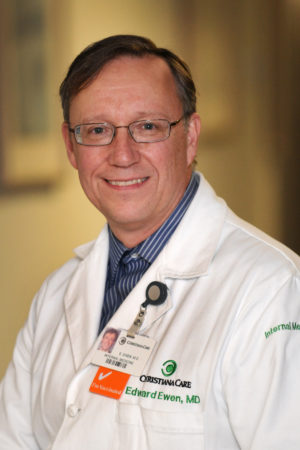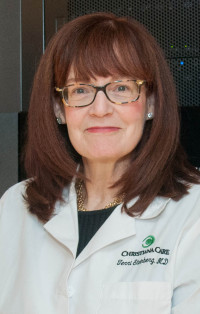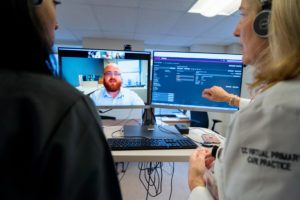
So much data exists today that no one person — or even a room full of experts — could possibly manage it all.
Yet hidden within that wealth of data are important clues that can help health systems predict which individuals are most likely to need certain services, and then customize programs specifically aimed toward helping them reach their optimal health.
Christiana Care’s new Data Analysis and Strategy team, under the direction of Edward Ewen, M.D., director of Clinical Data and Analytics, is hard at work developing ways to collect, organize and analyze data flowing into the system from a multitude of sources.

Analyzed and used properly, the business intelligence that results from “predictive analytics” could lead to more effective diagnoses, customized treatment plans and improved, measurable outcomes.
“Predictive analytics helps us target the patients who need the most care, and ensures that individuals get the right care when they need it,” said Christiana Care’s Chief Clinical Officer Kenneth Silverstein, M.D., MBA. “This new world of business intelligence converts data into useful information and puts it in the hands of the clinicians so they can improve care.”
This powerful capability becomes increasingly important as health systems, like Christiana Care, assume greater accountability for managing the health of large populations of individuals.

“We’re creating an uber-competency around data, one that allows us to translate ‘big data’ into something very precise based on who you are as a patient — your disease and your condition — where you are on that journey, and the social and economic conditions that we know have an impact on your outcome, said Randall Gaboriault, MS, chief information officer and senior vice president of Innovation and Strategic Development.
“We’re capturing the world around our patients and using data from the best-known science to identify patterns and help us reach the best measurable outcome for each specific individual,” he said. “This is precision health care.”
One size no longer fits all

Terri Steinberg, M.D., MBA, Christiana Care’s chief medical information officer and vice president for Population Health Informatics, said using predictive analytics is a bit like playing the iconic “Where’s Waldo?” game. On first glance, everyone in a population blends in with one another simply because of similarities in diagnosis. But when you study the picture carefully, patterns emerge that show which individuals are more likely to be at risk for complications due to other medical conditions, economic factors, cultural issues or even lifestyle challenges, such as being homeless or not having transportation. The conventional “one size fits all” approach to medicine no longer works for accountable care organizations.
“With predictive analytics, people who need more, or different, help ‘bubble” to the top,” said Dr. Steinberg. “Analytics help us find Waldo. They help us understand which people need to come to the attention of our care coordinators and be part of our new systems of care. We can then change the everyday life for a patient by becoming more efficient and effective, which in turn, controls the cost of care. It’s all about systems of care — sifting through large volumes of data about people and putting them in the system in the right place at the right time to address their needs.”
Take, for example, two people with diabetes. One is a 78-year old male; the other a 44 year-old female. Where “old world medicine” dictated that all patients with diabetes were treated in a certain way, predictive analytics calls on providers to learn about other factors impacting the person’s health and lifestyle and use that data to customize interventions that are most likely to be effective. That may include the same therapeutic care for each patient, but delivered in very different ways. In-home visits may work best for the 78-year-old male, while e-visits or tele-health monitoring may better suit the 44-year-old female.
“We need to architect our care delivery structures to reach people by disease state in a way that matches their own preference,” said Gaboriault. “This new world requires us to approach each person in a different way, helping them reach compliance with therapeutic care, engaging them and ensuring that they have the right access to the care they need.”
Marrying science with the patient perspective
The real power of data analytics is the capacity to marry the algorithms that appear from the information collected on the patient with the ever-evolving proliferation of evidence-based science.
Data flags, trigger tools and early warning systems alert providers to changes in a patient’s blood pressure, heart rate or blood sugar levels and allow them to adjust the care plan in real-time. Data patterns drawn from such variables as economic factors, social needs or past medical history help them figure out which patients are at greatest risk for complications that might land them in the hospital, who is most likely to return for readmission within Medicare’s 30-day window after leaving the hospital, and who needs what kind of community-based social support to effectively manage their condition.
Armed with this information, care managers from Christiana Care’s CareVio program are now able to focus on those at greatest risk and provide customized care in a way that best suits each person’s needs. Predictive analytics are equally valuable to providers within the hospital setting, for example guiding Emergency Department physicians in antibiotic stewardship or giving providers at the bedside the real-time knowledge they need to improve care for their patients.
Done well, predictive analytics takes many of the data points that until now providers have seen in isolation and finds new patterns in the data not immediately apparent to a human being.
“It enhances our ability to see what’s really happening with the patient; to see patterns and act on them.”
Edward F. Ewen, M.D., Data Analysis and Strategy team leader
“It isn’t magic; it’s science,” he said. “You can’t throw data into a blender and get the answer. Predictive analytics are only as good as the information going in. More data isn’t always better. We have to be able to act on it and effect outcomes.”
Technology could never replace the human provider in managing patient care. But harnessed effectively, data can help providers design customized, more effective interventions that reach people at the most treatable and lowest-cost point of the disease cycle before needs become acute.
“Organizations that figure this out are the ones that are going to succeed in health care,” said Gaboriault.


